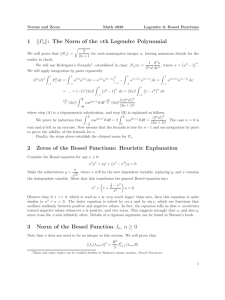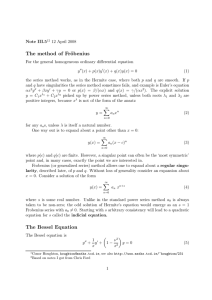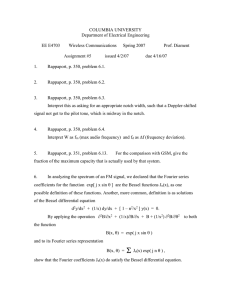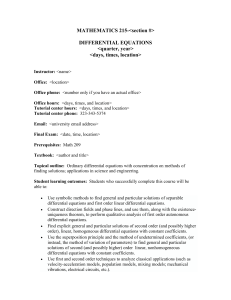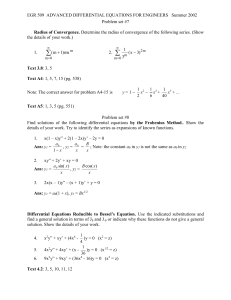Series solutions of differential equations and Bessel`s Equation
advertisement
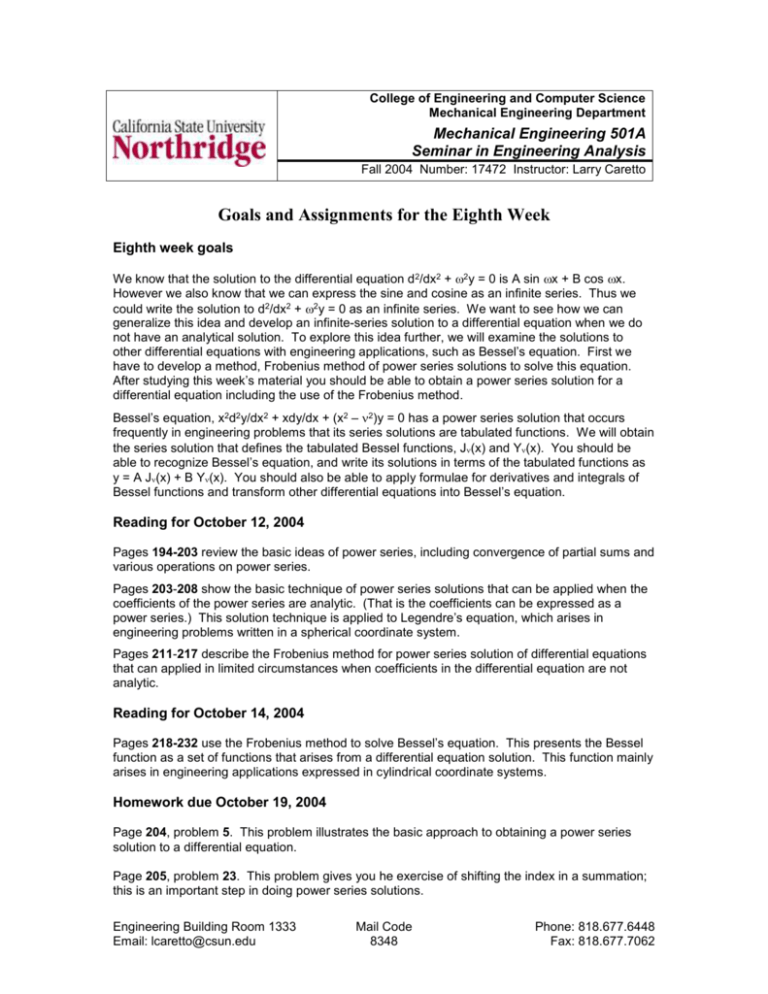
College of Engineering and Computer Science Mechanical Engineering Department Mechanical Engineering 501A Seminar in Engineering Analysis Fall 2004 Number: 17472 Instructor: Larry Caretto Goals and Assignments for the Eighth Week Eighth week goals We know that the solution to the differential equation d 2/dx2 + 2y = 0 is A sin x + B cos x. However we also know that we can express the sine and cosine as an infinite series. Thus we could write the solution to d2/dx2 + 2y = 0 as an infinite series. We want to see how we can generalize this idea and develop an infinite-series solution to a differential equation when we do not have an analytical solution. To explore this idea further, we will examine the solutions to other differential equations with engineering applications, such as Bessel’s equation. First we have to develop a method, Frobenius method of power series solutions to solve this equation. After studying this week’s material you should be able to obtain a power series solution for a differential equation including the use of the Frobenius method. Bessel’s equation, x2d2y/dx2 + xdy/dx + (x2 – 2)y = 0 has a power series solution that occurs frequently in engineering problems that its series solutions are tabulated functions. We will obtain the series solution that defines the tabulated Bessel functions, J(x) and Y(x). You should be able to recognize Bessel’s equation, and write its solutions in terms of the tabulated functions as y = A J(x) + B Y(x). You should also be able to apply formulae for derivatives and integrals of Bessel functions and transform other differential equations into Bessel’s equation. Reading for October 12, 2004 Pages 194-203 review the basic ideas of power series, including convergence of partial sums and various operations on power series. Pages 203-208 show the basic technique of power series solutions that can be applied when the coefficients of the power series are analytic. (That is the coefficients can be expressed as a power series.) This solution technique is applied to Legendre’s equation, which arises in engineering problems written in a spherical coordinate system. Pages 211-217 describe the Frobenius method for power series solution of differential equations that can applied in limited circumstances when coefficients in the differential equation are not analytic. Reading for October 14, 2004 Pages 218-232 use the Frobenius method to solve Bessel’s equation. This presents the Bessel function as a set of functions that arises from a differential equation solution. This function mainly arises in engineering applications expressed in cylindrical coordinate systems. Homework due October 19, 2004 Page 204, problem 5. This problem illustrates the basic approach to obtaining a power series solution to a differential equation. Page 205, problem 23. This problem gives you he exercise of shifting the index in a summation; this is an important step in doing power series solutions. Engineering Building Room 1333 Email: lcaretto@csun.edu Mail Code 8348 Phone: 818.677.6448 Fax: 818.677.7062 Assignments for week eight ME 501A, L. S. Caretto, Fall 2004 Page 2 Page 216, problem 9. This is an application of the Frobenius method to the solution of a differential equation. Page 226, problem 23. This application of integral formulas for Bessel functions is important in solutions of differential equations involving Bessel function expansions. Page 232, problems 7 and 14. These problems show how some differential equations can be transformed into equations that can be solved in terms of Bessel functions. Problem 14 introduces the modified Bessel function that arises in the analysis of heat transfer from circular fins.




